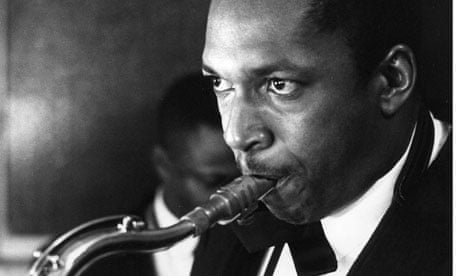Miles Davis was a good authority on the saxophonist John Coltrane, who played in one of the trumpeter's bands in the 1950s. Their time spent working together began with Davis's rise to stardom and ended not long after the magnificent Kind of Blue, on which Coltrane played a masterful role. In his autobiography written with Quincy Troupe, Davis summed up Coltrane:
"Trane was the loudest, fastest saxophonist I've ever heard. He could play real fast and real loud at the same time and that's very difficult to do ... it was like he was possessed when he put that horn in his mouth. He was so passionate- fierce – and yet so quiet and gentle when he wasn't playing."
Coltrane, who died of liver failure at 40, has probably been the most influential saxophonist in any musical genre, including Lester Young, Ornette Coleman, Sonny Rollins and even Charlie Parker. His dazzling solos are now transcribed as exercises for students, while players all over the world still try to mimic his characteristically intense and soulful sound more than 40 years after his death.
Giant Steps, an astonishing tenor-saxophone improvisation Coltrane recorded in 1959, has been a model for aspiring sax players ever since, but it's far more than a technical exercise, pointing the way toward the lava-flows of scales and runs that the critic Ira Gitler famously described as "sheets of sound". Like an engineer obsessively building a machine that could blast free of the restraints of time, space and mortality, Coltrane assembled a distinctive technique from miniscule parts and infinitesimal details. But his mission was to fuse them all into one single, huge, imploring sound in which all the details, while crucial, were no longer individually audible. For him, Giant Steps was more like a first step.
This was music to dazzle jazz fans, but Coltrane was to unexpectedly win over a completely new audience with his best-known album, the much more contemplative A Love Supreme, from 1964. It became a hit with the hippy audience of the day (and with plenty of rock guitarists too), notably for the mantra-like chant inspired by Coltrane's absorption in Indian music and eastern religious thought. His sense of victory over alcohol and heroin use, which had undermined his health and resulted in Miles Davis firing him twice, also contributed to the album (though it turned out to be tragically shortlived).
Born in Hamlet, North Carolina on 23 September 1926, Coltrane took up alto saxophone at 15, after beginning his musical education on alto horn and clarinet. Music studies at college were interrupted by military service, but Coltrane played in navy bands, and switched to tenor sax to work with r'n'b stars Eddie "Cleanhead" Vinson and Earl Bostic in 1947. Influenced by Dexter Gordon and Charlie Parker, and later Sonny Rollins, then Sun Ra tenorist John Gilmore, Coltrane steadily developed his own style; laboriously at first, and then with growing assurance and freedom. He played in the prestigious Dizzy Gillespie Orchestra, and with Duke Ellington saxophonist Johnny Hodges's group in the early 50s, with the organist Jimmy Smith, and then from 1955 with Miles Davis. Later that decade, Coltrane also worked briefly in an adventurous and now legendary quartet with pianist Thelonious Monk.
Coltrane pushed bebop as far as it could go with Giant Steps, then began exploring overtones to play off-the-register high sounds and more than one note at a time ("multiphonics"). He revolutionised scale-based "modal" improvising, and with his 60s quartet featuring pianist McCoy Tyner, bassist Jimmy Garrison and drummer Elvin Jones, produced some of the most creative and exciting small-group jazz of all time. Coltrane also took up the then rarely used soprano saxophone, which he played on his famous version of My Favourite Things.
Coltrane forged on through the 60s, shedding and recruiting band-members on the way, providing a model for the difficult art of larger-group free-improv with his 1965 recording Ascension, and in his final years forming an uncompromising new band with his second wife, Alice, on keyboards, saxophonist Pharoah Sanders, and Rashied Ali – a more abstract, textural performer than Elvin Jones had been – on drums and percussion. John Coltrane died in New York on 17 July 1967.

Comments (…)
Sign in or create your Guardian account to join the discussion